Computer Networking 101: What is Cat 5 Ethernet Cable
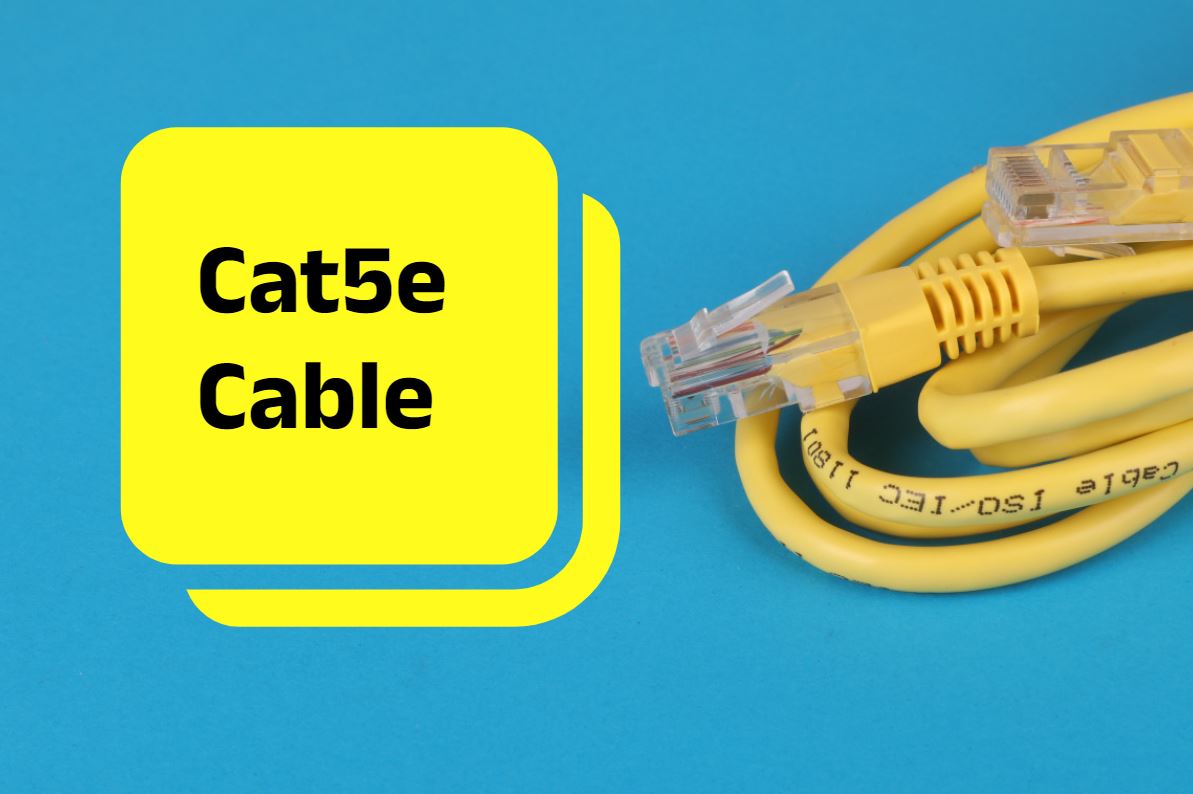
Table of Contents
The twisted pair of category 5, 5e (cat 5, cat 5e, cat 5e) is used as the main material for building data transmission networks. It was in the recent past widespread as a basic cable for the installation of lines in the arrangement of video surveillance systems, alarm systems, and communication networks.
Fast Ethernet networks, when using a twisted pair UTP-5e, FTP-5e guarantee an increase in data transfer speeds up to 1000 Mbit/s. The characteristics are achievable if the distance between the network components is no more than one hundred meters.
What is a Category 5 Cable?
Category 5 cable (Cat. 5) is a type of signal transmission cable consisting of 4 twisted pairs. It is used for computer networks such as Ethernet. The cable standard provides performance up to 100 MHz and is suitable for 10BASE-T, 100BASE-TX (Fast Ethernet), and 1000BASE-T (Gigabit Ethernet). It is also used for telephony and video signal transmission.
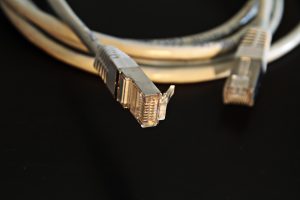
The cable is terminated by a modular RJ45 connector or on a patch panel. Most Category 5 cables are unshielded. To combat interference, only the properties of the twisted pair are used when transmitting differential signals. Maximum length (maximum certified length) Cat 5 cables or cross cables is 100 meters.
What is a Category 5e Cable?
Category 5e cable, also known as Cat 5e or Category 5 Enhanced, is a network cable standard ratified in 1999. Cat 5e offers significantly improved performance compared to the old Cat 5 standard, including a speed increase of up to 10 times and a significantly greater ability to travel distances without being affected by crosstalk.
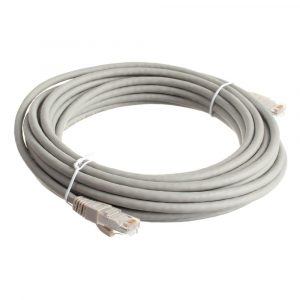
Category 5e cables are usually 24-gauge twisted pairs supporting gigabit networks at distances between segments up to 100 meters. Cat 5e cables are deployed in many places. For example, it can be used in a home network environment with different lengths. Another common use of Cat 5e cable is indoor cabling.
Category 5 Cable vs. Category 5e Cable
The differences between Cat 5 and Cat 5e cables are shown in performance: network maintenance, crosstalk, and bandwidth. The Cat 5e cable supports Ethernet, Fast Ethernet, and Gigabit Ethernet speeds, and the Cat5 cable speed is only for the previous two.
The Category 5e cable is fully backward compatible and can be used in any applications that typically use a Category 5 cable. In addition, crosstalk has already been significantly reduced in Cat 5e wiring compared to Cat 5 cable. Moreover, the Cat 5e cable has 350MHz power, which allows for higher bandwidth than Cat 5.
UTP and FTP
A typical twisted pair of UTP and FTP is a cable twisted from 2-4 pairs of conductors. Each conductor has its own insulating shell made of plastic. The composition of the shell varies depending on the operating conditions: the shell of twisted pair conductors for internal networks is made of PVC, for external (street) and unprotected networks – from polyethylene, which is explained by the greater elasticity and temperature resistance of the latter.
The products are designed for long-term operation without loss of technical characteristics and physical deformations. The stability of the cable parameters is ensured by the presence of special fixing elements in its structure. The latter retain the location and geometry parameters of paired conductors.
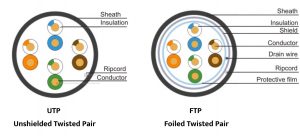
In order to avoid surprises when installing a category 5E twisted pair, you need to know exactly the diameter of the cable. The fact is that although it has the same caliber as the inner conductor 24AWG and conductors of the same diameter — 0.511 mm, its overall thickness depends on other aspects.
What affects the thickness of the Internet cable:
- number of conductors
- shell diameter
- the presence of shielding
Let’s look at everything in a little more detail.
UTP Cat 5E Technical Specifications
UTP twisted pair is a model without a protective shield with two or four pairs of solid type conductors.
The diameter of the components of such a cord:
- conductor: 0.51± 0.01 mm;
- insulation: dense polyethylene, with a diameter of at least 0.18 mm;
- wire: 0.92±0.02mm;
- PVC sheath of internal conductors: from 0.4mm;
- * outer diameter: 4.6=0.2mm.
It turns out that the total thickness of an unshielded twisted pair of category 5E will vary depending on the number of conductors. For example, with four pairs, the outer diameter of the cable will already be 5.1 ± 0.2 mm.
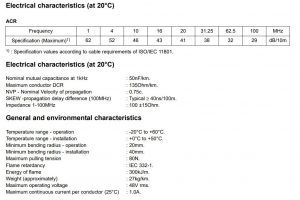
FTP Cat 5e Technical Specifications
Such models contain at least 4 conductors. They are supplemented with a protective foil shield and a special dielectric wire designed to divert current. Also, such a network cable is equipped with an outer shell and a protective film.
The diameter of the conductors and insulation of the FTP cable, which belongs to category 5E, is identical to the indicators of the unshielded model. However, there are differences. They consist in:
- protective shield: its dimensions are 0.025 mm x 20 mm;
- the presence of a drainage wire: its diameter is 0.5 mm;
- shell thickness — from 0.65 mm.
- the outer diameter of such a connecting cord will be at least 7.0 ± 0.2 mm.
We should also talk about the category 5E FTP cable for outdoor use. The dimensions of its components are the same as those of a shielded twisted pair designed for internal mounting. However, the model is also supplemented with a steel cable, which enhances protection against mechanical loads. The diameter of this component is approximately two millimeters (± 0.1 mm).
If the grounding wire is not located next to the conductors but is taken out separately, then the thickness of its shell is also added. Its thickness is about 0.6 millimeters (± 0.05 mm).
It is also worth considering the bending radius. The indicator is calculated as follows: during installation, it will be 8xØ, with vertical calibration — 6xØ, and with horizontal calibration — 4xØ.
Knowing what diameter each component of the twisted pair has and how to calculate the bending radius, you will greatly simplify the installation of a category 5E cable.
Electrical Characteristics for Cat 5e UTP
| Property | Nominal | Tolerance | Unit |
| Characteristic impedance, 1–100 MHz | 100 | ± 15 | Ω |
| Characteristic impedance @ 100 MHz | 100 | ± 5 | Ω |
| DC loop resistance | ≤ 0.188 | Ω/m | |
| Propagation speed relative to the speed of light | 0.64 | 1 | |
| Propagation delay | 5.3 | ns/m | |
| Delay skew < 100 MHz | < 0.20 | ns/m | |
| Capacitance at 800 Hz | 52 | pF/m | |
| Max tensile load, during installation | 100 | N | |
| Wire diameter (24 AWG; 0.205 mm2)) | 0.51 | mm | |
| Operating temperature | −55 to +60 | °C | |
| Maximum DC operating voltage | |||
| (PoE uses max 57 V)[25] | 125 | V |
Source: Category 5 cable WikiPedia
